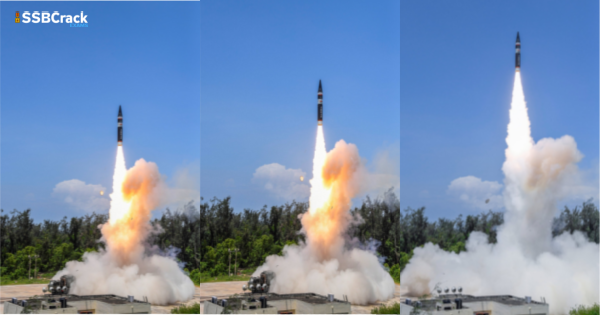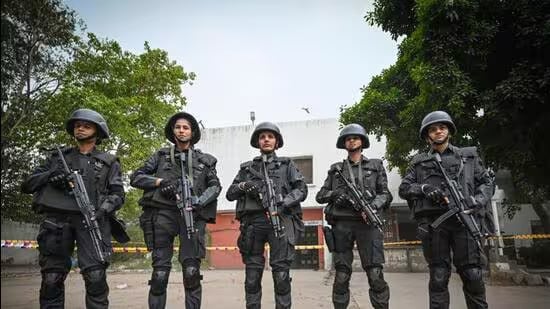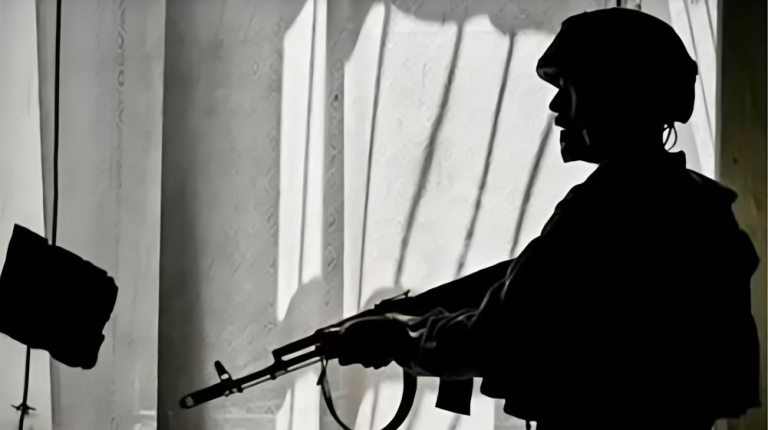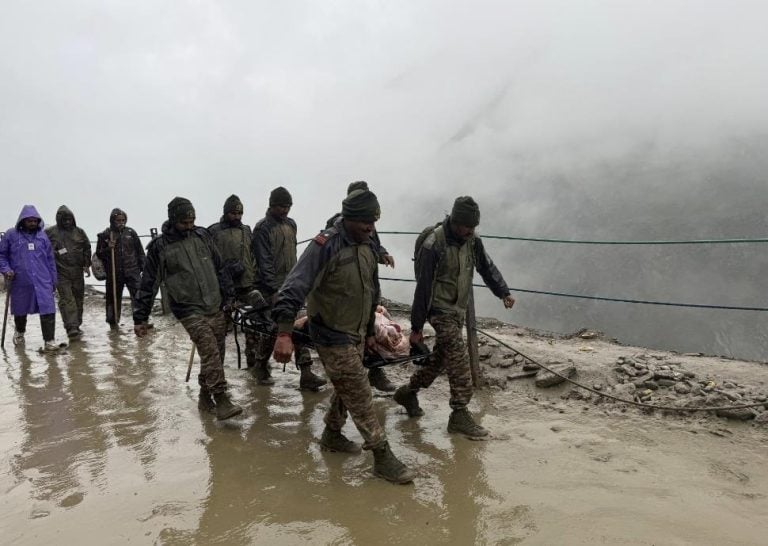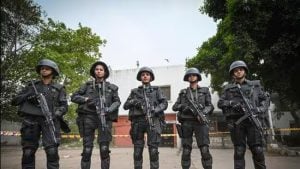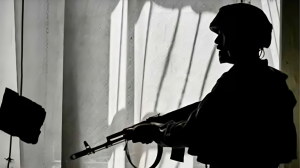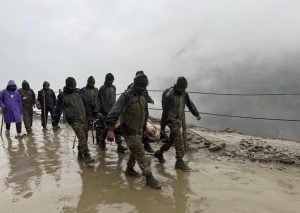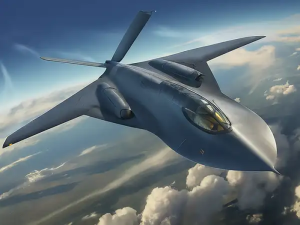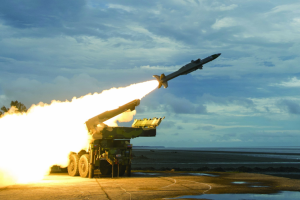India had 160 nuclear warheads as of January 2022 and it appears to be expanding its nuclear arsenal, Stockholm-based defence think tank SIPRI claimed on Monday. Similarly, Pakistan also appears to be expanding its nuclear arsenal, the Stockholm International Peace Research Institute (SIPRI) said in a statement. “China is in the middle of a substantial expansion of its nuclear weapon arsenal, which satellite images indicate includes the construction of over 300 new missile silos,” SIPRI’s statement noted. SIPRI estimates that the total inventory of India has increased from 156 warheads in January 2021 to 160 warheads in January 2022.
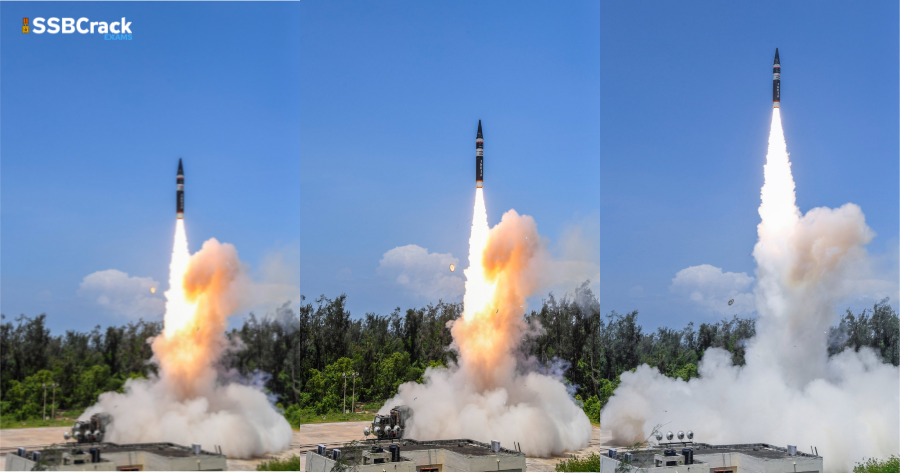
Recently A successful training launch of an Intermediate-Range Ballistic Missile, Agni-4, was carried out at approximately 1930 hours on June 06, 2022, from APJ Abdul Kalam Island, Odisha and on 25th December 2021, DRDO successfully tested the new generation nuclear capable ballistic missile ‘Agni P’ from Dr APJ Abdul Kalam island off the coast of Odisha.
The nine nuclear-armed states—the United States, Russia, the United Kingdom, France, China, India, Pakistan, Israel and the Democratic People’s Republic of Korea (North Korea)—continue to modernize their nuclear arsenals and although the total number of nuclear weapons declined slightly between January 2021 and January 2022 (see table below), the number will probably increase in the next decade.
World nuclear forces, January 2020
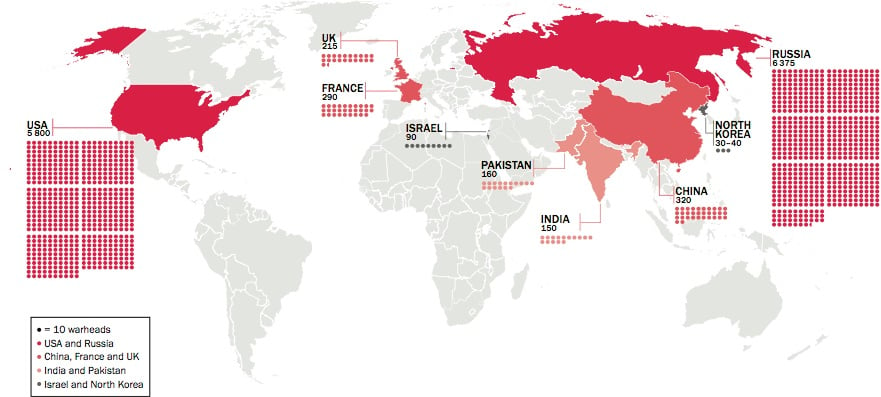
Of the total inventory of an estimated 12 705 warheads at the start of 2022, about 9440 were in military stockpiles for potential use. Of those, an estimated 3732 warheads were deployed with missiles and aircraft, and around 2000—nearly all of which belonged to Russia or the USA—were kept in a state of high operational alert.
Although Russian and US total warhead inventories continued to decline in 2021, this was due to the dismantling of warheads that had been retired from military service several years ago. The number of warheads in the two countries’ useable military stockpiles remained relatively stable in 2021. Both countries’ deployed strategic nuclear forces were within the limits set by a bilateral nuclear arms reduction treaty (2010 Treaty on Measures for the Further Reduction and Limitation of Strategic Offensive Arms, New START). Note, however, that New START does not limit total non-strategic nuclear warhead inventories.
Also Read: Top 10 Countries In World Military Expenditure 2021 [Complete Report]
‘There are clear indications that the reductions that have characterized global nuclear arsenals since the end of the cold war have ended,’ said Hans M. Kristensen, Associate Senior Fellow with SIPRI’s Weapons of Mass Destruction Programme and Director of the Nuclear Information Project at the Federation of American Scientists (FAS).
‘All of the nuclear-armed states are increasing or upgrading their arsenals and most are sharpening nuclear rhetoric and the role nuclear weapons play in their military strategies,’ said Wilfred Wan, Director of SIPRI’s Weapons of Mass Destruction Programme. ‘This is a very worrying trend.’
Russia and the USA together possess over 90 per cent of all nuclear weapons. The other seven nuclear-armed states are either developing or deploying new weapon systems, or have announced their intention to do so. China is in the middle of a substantial expansion of its nuclear weapon arsenal, which satellite images indicate includes the construction of over 300 new missile silos. Several additional nuclear warheads are thought to have been assigned to operational forces in 2021 following the delivery of new mobile launchers and a submarine.
World nuclear forces, January 2022
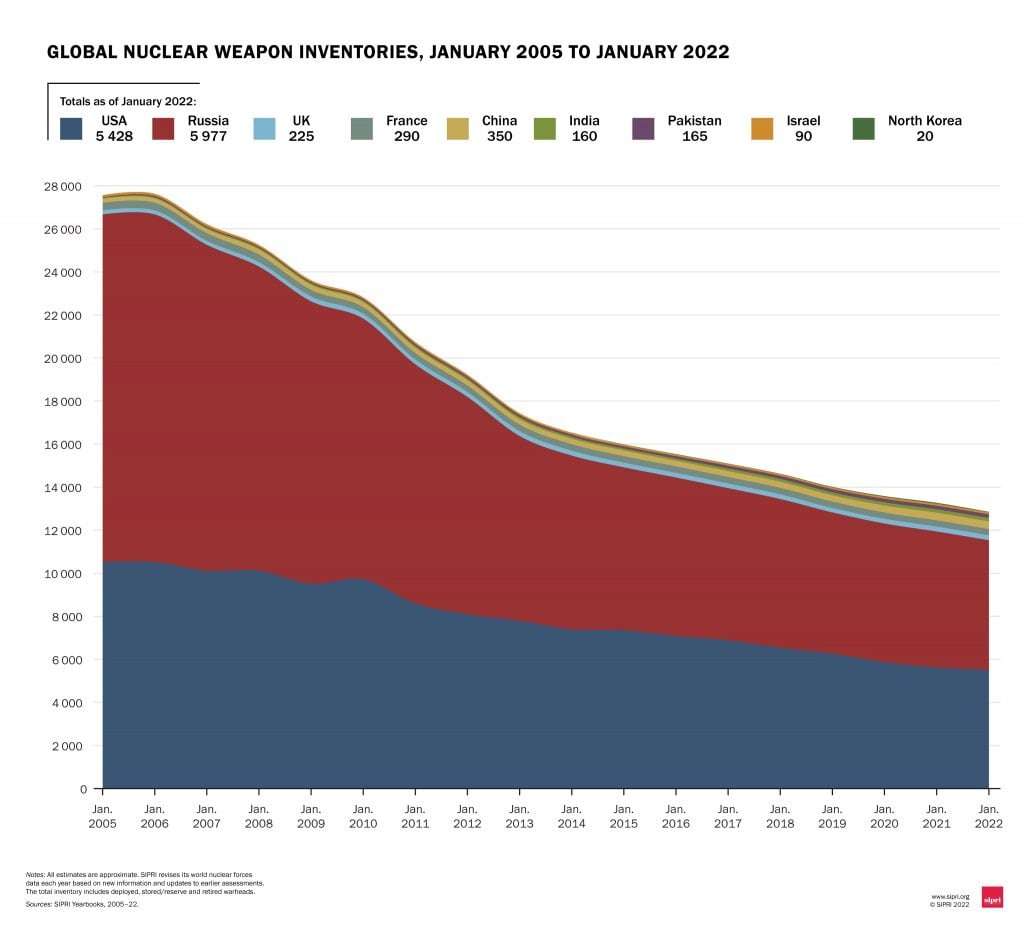
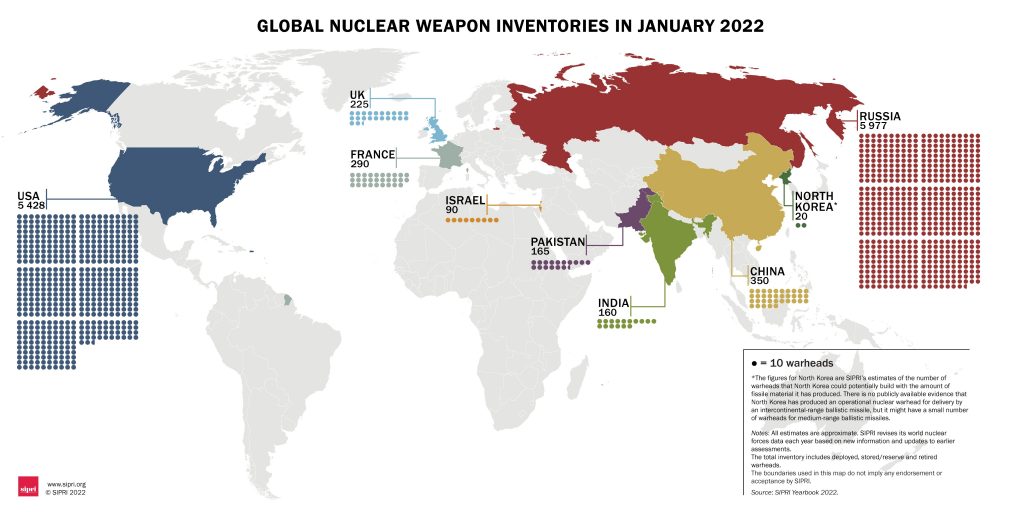
| Country | Deployed warheadsa | Stored warheadsb | Total stockpileb | Total inventory 2022b | Total inventory 2021b |
| United States | 1 744 | 1 964 | 3 708 | 5 428 | 5 550 |
| Russia | 1 588 | 2 889 | 4 477 | 5 977 | 6 255 |
| United Kingdom | 120e | 60f | 180f | 225f | 225 |
| France | 280 | 10 | 290 | 290 | 290 |
| China | 350g | 350g | 350g | 350 | |
| India | 160 | 160 | 160 | 156 | |
| Pakistan | 165 | 165 | 165 | 165 | |
| Israel | 90 | 90 | 90 | 90 | |
| North Korea | .. | 20h | 20h | 20h | [40–50]h |
| Total | 3 732 | 5 708 | 9 440 | 12 705 | 13 080 |
Source: SIPRI Yearbook 2022
Notes: All estimates are approximate. SIPRI revises its world nuclear forces data each year based on new information and updates to earlier assessments. The figures for Russia and the USA do not necessarily correspond to those in their 2010 Treaty on Measures for the Further Reduction and Limitation of Strategic Offensive Arms (New START) declarations because of the treaty’s counting rules. SIPRI estimates that the total inventory of India has increased from 156 warheads in January 2021 to 160 warheads in January 2022.
Also Read: Indian Air Force Ranks 3rd On World Air Power Index
a ‘Deployed warheads’ refers to warheads placed on missiles or located on bases with operational forces. b ‘Stored warheads’ refers to stored or reserve warheads that would require some preparation (e.g. transport and loading on to launchers) before they could be deployed. c ‘Total stockpile’ refers to warheads that are intended for use by the armed forces. d ‘Total inventory’ includes stockpiled warheads plus retired warheads awaiting dismantlement. e This figure is for warheads that are operationally available for the UK’s three deployable nuclear-powered ballistic missile submarines (the fourth submarine is in refit). In 2021 the UK declared that it will no longer publicly disclose numbers of operationally available warheads, deployed warheads or deployed missiles. f The British Government declared in 2010 that its nuclear weapon stockpile would not exceed 225 warheads. The official meaning of the term ‘stockpile’ appears to refer to the total warhead inventory that includes both useable and retired warheads to be dismantled. SIPRI estimates that the total inventory remained at 225 warheads in January 2022. A government review published in 2021 raised the ceiling for the future stockpile from 225 to 260. g Even though SIPRI’s estimate of China’s total inventory is the same as for January 2021, the number of stockpiled warheads potentially available for use has changed because new launchers became operational during 2021. h Whereas in previous SIPRI yearbooks figures for North Korea were SIPRI’s estimates of the number of warheads that North Korea could build with the amount of fissile material it has produced, this year the estimate is for the number of actual assembled warheads North Korea possesses. The country’s inventory of fissile material is believed to have grown in 2021, to perhaps enough to produce 45–55 warheads. There is no publicly available evidence that North Korea has produced an operational nuclear warhead for delivery by an intercontinental-range ballistic missile, but it might have a small number of warheads for medium-range ballistic missiles. The figures for North Korea are for the first time included in the global totals.
The UK in 2021 announced its decision to increase the ceiling on its total warhead stockpile, in a reversal of decades of gradual disarmament policies. While criticizing China and Russia for lack of nuclear transparency, the UK also announced that it would no longer publicly disclose figures for the country’s operational nuclear weapon stockpile, deployed warheads or deployed missiles.
In early 2021 France officially launched a programme to develop a third-generation nuclear-powered ballistic missile submarine (SSBN). India and Pakistan appear to be expanding their nuclear arsenals, and both countries introduced and continued to develop new types of nuclear delivery system in 2021. Israel—which does not publicly acknowledge possessing nuclear weapons—is also believed to be modernizing its nuclear arsenal.
North Korea continues to prioritize its military nuclear programme as a central element of its national security strategy. While North Korea conducted no nuclear test explosions or long-range ballistic missile tests during 2021, SIPRI estimates that the country has now assembled up to 20 warheads, and possesses enough fissile material for a total of 45–55 warheads.
‘If the nuclear-armed states take no immediate and concrete action on disarmament, then the global inventory of nuclear warheads could soon begin to increase for the first time since the cold war,’ said Matt Korda, Associate Researcher with SIPRI’s Weapons of Mass Destruction Programme and Senior Research Associate with the FAS Nuclear Information Project.
Mixed signals from nuclear diplomacy
There were several landmarks in nuclear diplomacy during the past year. These included the entry into force of the Treaty on the Prohibition of Nuclear Weapons (TPNW) in January 2021, having received the required 50 state ratifications; the extension for five years of New START, the last remaining bilateral arms control agreement between the world’s two leading nuclear powers; and the start of talks on the USA rejoining, and Iran returning to compliance with, the Iran nuclear deal, the Joint Comprehensive Plan of Action (JCPOA).
During 2021, the nuclear-armed permanent members (P5) of the United Nations Security Council—China, France, Russia, the UK and the USA—worked on a joint statement that they issued on 3 January 2022, affirming that ‘nuclear war cannot be won and must never be fought’. They also reaffirmed their commitment to complying with non-proliferation, disarmament and arms control agreements and pledges as well as their obligations under the 1968 Treaty on the Non-Proliferation of Nuclear Weapons, and pursuing the goal of a world without nuclear weapons.
Despite this, all P5 members continue to expand or modernize their nuclear arsenals and appear to be increasing the salience of nuclear weapons in their military strategies. Russia has even made open threats about possible nuclear weapon use in the context of the war in Ukraine. Bilateral Russia–USA strategic stability talks have stalled because of the war, and none of the other nuclear-armed states are pursuing arms control negotiations. Moreover, the P5 members have voiced opposition to the TPNW, and the JCPOA negotiations have not yet reached a resolution.
‘Although there were some significant gains in both nuclear arms control and nuclear disarmament in the past year, the risk of nuclear weapons being used seems higher now than at any time since the height of the cold war,’ said SIPRI Director Dan Smith.
To join the Indian Armed Forces as an Officer and crack the SSB interview, You can join our SSB interview live classes batch and we recommend you to Enroll SSB INTERVIEW ONLINE COURSE. Trusted by thousands of defence aspirants.
Also Read:


